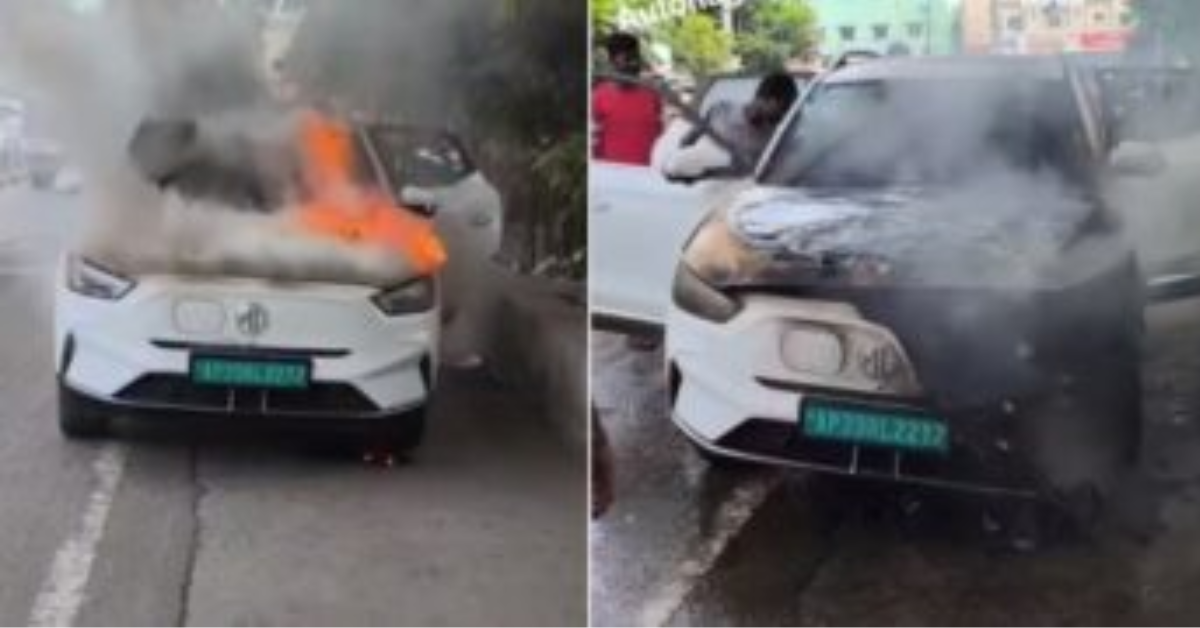Electric Vehicles (EVs) are being hailed as the future of mobility in India. With rising fuel costs, government incentives, and a strong push toward sustainability, more consumers are shifting to EVs than ever before. However, with rapid adoption comes growing concern — and incidents of EV fires have raised critical questions about safety.
Recently, a popular electric vehicle caught fire in Vijayawada, and a video of the incident quickly went viral on social media. The visuals left many shocked, as flames engulfed the vehicle within minutes. While no casualties were reported, the event has once again brought EV safety into the spotlight.
This blog takes a detailed look at what happened in Vijayawada, why EVs catch fire, and what steps manufacturers, authorities, and consumers can take to prevent such tragedies.
The Vijayawada EV Fire Incident: What We Know
According to reports and viral video clips, the incident took place in Vijayawada when a parked EV suddenly caught fire and was reduced to ashes within minutes. Passersby noticed smoke emanating from the vehicle, and soon flames spread uncontrollably.
Key points from the incident:
- The vehicle was one of the popular EV models in India.
- It appears the fire started near the battery compartment.
- Firefighters were able to control the blaze, but the EV was completely destroyed.
- Thankfully, no injuries or loss of life were reported.
While official investigations are underway, the event has intensified debates over the safety of EV batteries and whether manufacturers are doing enough to prevent such incidents.
Why Do EVs Catch Fire?
EV fires are not as common as petrol or diesel vehicle fires, but when they occur, they spread faster and are harder to control due to the chemistry of lithium-ion batteries.
Possible causes include:
- Thermal Runaway
Lithium-ion batteries can overheat if a single cell malfunctions. This can trigger a chain reaction, leading to fire or explosion. - Poor Battery Management Systems (BMS)
A weak or faulty BMS fails to regulate charging, discharging, and heat, making the battery prone to overheating. - Overcharging or Fast Charging
Rapid charging cycles, if not properly managed, may overheat battery cells. - Manufacturing Defects
Substandard components or poor quality control during production increase the risk of short circuits and fires. - External Factors
Extreme heat, physical damage from potholes/accidents, or exposure to water can compromise battery safety.
Global vs Indian Context
Globally, EV fires have been reported with big brands like Tesla, Hyundai, and Chevrolet. However, India’s situation is more delicate because:
- Climate Conditions: High temperatures in Indian cities like Vijayawada stress batteries more than in cooler regions.
- Infrastructure Gaps: Lack of standardized charging infrastructure sometimes forces unsafe charging practices.
- Cost Pressure: To keep EVs affordable, some manufacturers may cut corners in battery safety and quality control.
The Vijayawada incident is not the first — similar cases have been reported in Pune, Hyderabad, and Chennai in the past two years. Each incident highlights the urgent need for stronger EV safety norms in India.
How Manufacturers Are Responding
EV makers are aware of the growing safety concerns. Following earlier fire incidents in India, the government ordered an investigation into multiple EV brands. Some manufacturers issued voluntary recalls to fix faulty battery packs and software issues.
Steps being taken include:
- Stricter Quality Checks before dispatch.
- Software Updates to improve thermal management.
- Enhanced Cooling Systems in battery designs.
- Fire-Resistant Materials for enclosures.
Yet, the Vijayawada fire shows that more needs to be done to regain consumer confidence.
What the Government Is Doing
The Indian government has been proactive in addressing EV fire risks:
- Battery Safety Standards: New rules mandate testing under extreme conditions, including vibration, thermal shock, and water exposure.
- Certification Requirements: All EV battery packs must comply with AIS 156 and AIS 038 standards.
- Incentives for Safer Tech: Subsidies and schemes now encourage adoption of better battery chemistry like solid-state or LFP (Lithium Iron Phosphate).
- Recall Policies: Manufacturers face penalties if safety issues are ignored.
Still, enforcement is key. Consumers expect not just regulations but accountability and transparency in implementation.
What EV Owners Can Do to Stay Safe
While systemic improvements are essential, EV users can also take steps to minimize risks:
- Use Approved Chargers Only: Avoid unregulated fast chargers that may damage the battery.
- Avoid Overcharging: Do not leave the EV plugged in overnight unnecessarily.
- Regular Servicing: Ensure periodic battery health checks at authorized service centers.
- Park Safely: Avoid direct sunlight for long hours, especially in high-temperature regions.
- Stay Alert: If you notice unusual smells, smoke, or sudden drops in battery range, seek immediate inspection.
Being proactive can help prevent small issues from escalating into fire hazards.
Consumer Concerns and Market Impact
The Vijayawada fire has triggered a wave of discussions online. Many potential EV buyers are now rethinking their decisions, while existing owners are demanding clarity from manufacturers.
However, experts suggest that while EV fires are concerning, they are still relatively rare compared to petrol or diesel vehicle fires. With stricter norms and advancing technology, EVs will only get safer.
But the incident is a reminder: safety must never take a back seat in the race for electrification.
The Road Ahead for EVs in India
India’s EV dream is strong, and incidents like the Vijayawada fire shouldn’t derail progress. Instead, they should serve as catalysts for:
- More robust safety R&D.
- Better consumer awareness campaigns.
- Transparent communication from brands during recalls and safety updates.
- Focus on advanced chemistries like solid-state batteries, which are less prone to fire.
The EV revolution is inevitable, but it must be built on a foundation of trust and safety.
Conclusion
The Vijayawada EV fire has shaken public confidence but also provided a crucial wake-up call. As India accelerates toward an all-electric future, manufacturers, regulators, and consumers must work together to ensure such incidents become exceedingly rare.
EVs represent the future of green mobility — but for that future to be truly sustainable, safety must be the top priority. The lesson from Vijayawada is clear: innovation should never outrun responsibility.



